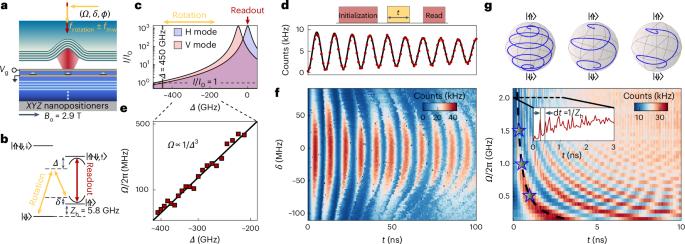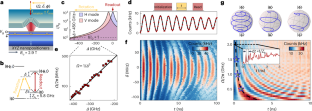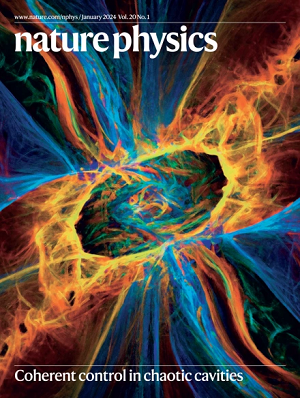Fast optical control of a coherent hole spin in a microcavity
IF 18.4
1区 物理与天体物理
Q1 PHYSICS, MULTIDISCIPLINARY
引用次数: 0
Abstract
Many of the most promising quantum information platforms store quantum information in electronic or atomic spins. To incorporate these devices into quantum networks, a spin–photon interface is required. Currently, the best on-demand single-photon sources use a semiconductor quantum dot in an engineered photonic environment. However, it is difficult to achieve coherent spin control in a high-performance single-photon source, and spin coherence is limited by magnetic noise from nuclear spins in the semiconductor host material. Here we combine all-optical spin control with a quantum dot in an open microcavity. We demonstrate fast coherent rotations of a hole spin around an arbitrary axis of the Bloch sphere with a maximum π-pulse fidelity of 98.6%. To suppress the slow magnetic noise, we laser cool the nuclear spins using the hole as a central spin. This extends the hole spin free-induction-decay time by more than an order of magnitude. It becomes much larger than both rotation time and radiative recombination time of the spin, enabling the creation of many spin–photon pairs before the loss of spin coherence. Spin–photon interfaces provide a connection between quantum information stored in atomic or electronic spins and optical communications networks. A quantum photon emitter with long-lived, controllable coherent spin has now been demonstrated.


微腔中相干空穴自旋的快速光学控制
许多最有前途的量子信息平台将量子信息存储在电子或原子自旋中。为了将这些设备整合到量子网络中,需要一个自旋光子接口。目前,最好的按需单光子源在工程光子环境中使用半导体量子点。然而,在高性能单光子源中实现相干自旋控制是困难的,并且自旋相干性受到半导体宿主材料中核自旋产生的磁噪声的限制。在这里,我们将全光自旋控制与开放微腔中的量子点结合起来。我们证明了一个空穴围绕布洛赫球任意轴的快速相干旋转,最大π脉冲保真度达到98.6%。为了抑制缓慢的磁噪声,我们用激光冷却核自旋,利用这个空穴作为中心自旋。这将空穴自旋自由感应衰变时间延长了一个数量级以上。它比自旋的旋转时间和辐射复合时间都要大得多,使得在自旋相干性丧失之前能够产生许多自旋光子对。
本文章由计算机程序翻译,如有差异,请以英文原文为准。
求助全文
约1分钟内获得全文
求助全文
来源期刊

Nature Physics
物理-物理:综合
CiteScore
30.40
自引率
2.00%
发文量
349
审稿时长
4-8 weeks
期刊介绍:
Nature Physics is dedicated to publishing top-tier original research in physics with a fair and rigorous review process. It provides high visibility and access to a broad readership, maintaining high standards in copy editing and production, ensuring rapid publication, and maintaining independence from academic societies and other vested interests.
The journal presents two main research paper formats: Letters and Articles. Alongside primary research, Nature Physics serves as a central source for valuable information within the physics community through Review Articles, News & Views, Research Highlights covering crucial developments across the physics literature, Commentaries, Book Reviews, and Correspondence.
 求助内容:
求助内容: 应助结果提醒方式:
应助结果提醒方式:


